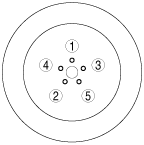 |
GENERAL PROCEDURES (BRAKE)
id041000800100
Wheel and Tire Installation
1. When installing the wheels and tires, tighten the wheel nuts in a criss-cross pattern to the following tightening torque.
ac5wzw00000370
|
Brake Lines Disconnection
1. If any brake line has been disconnected during the procedures, add brake fluid, bleed the brakes, and inspect for leakage after the procedure has been completed.
Brake Pipe Flare Nut Tightening
1. Tighten the brake pipe flare nut using any commercially available flare nut wrench.
Connector Disconnection
1. Disconnect the negative battery cable before performing any work that requires handling of connectors. (See NEGATIVE BATTERY CABLE DISCONNECTION/CONNECTION [SKYACTIV-G 2.0, SKYACTIV-G 2.5 (WITHOUT i-stop)].) (See NEGATIVE BATTERY CABLE DISCONNECTION/CONNECTION [SKYACTIV-G 2.0, SKYACTIV-G 2.5].) (See NEGATIVE BATTERY CABLE DISCONNECTION/CONNECTION [SKYACTIV-D 2.2].)
DSC Related Parts
1. Make sure that there are no DTCs in the DSC memory after working on DSC related parts. If there are any DTCs in the memory, clear them. (See ON-BOARD DIAGNOSIS [DYNAMIC STABILITY CONTROL (DSC)].)
DSC Related Part Sensor Initialization Procedure
1. When replacing the following parts, perform the initialization procedure. (See DSC RELATED PARTS SENSOR INITIALIZATION PROCEDURE.)
Tire Pressure Monitoring System (TPMS) Initialization Procedure (Vehicles with TPMS)
1. Perform the TPMS initialization procedure when the TPMS warning light illuminates. (See TIRE PRESSURE MONITORING SYSTEM INITIALIZATION PROCEDURE.)